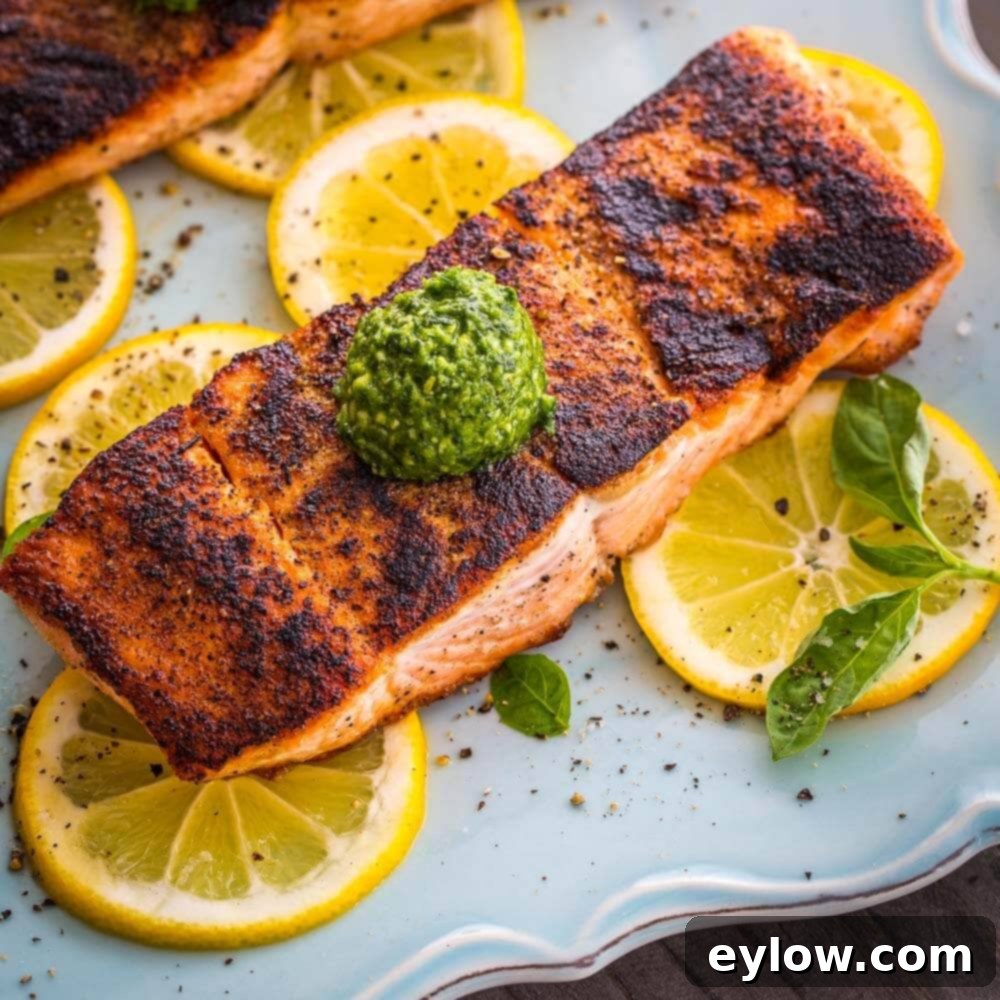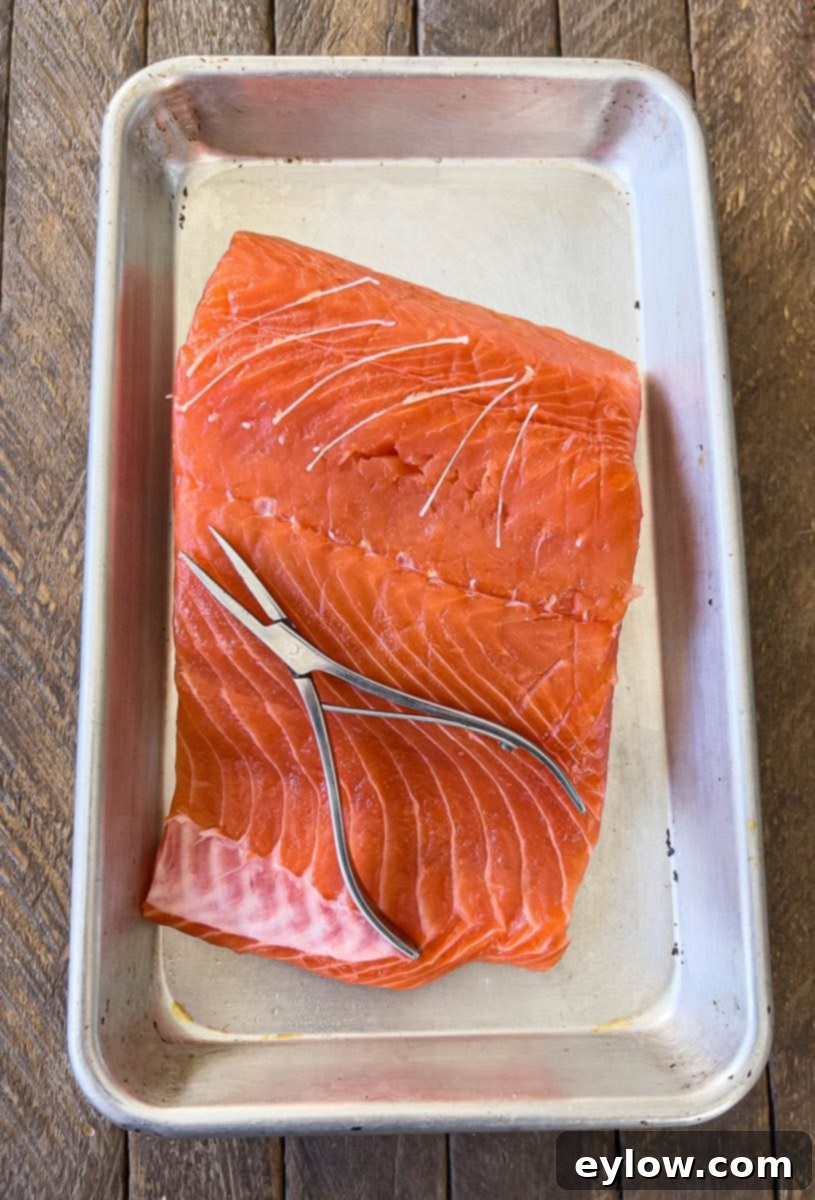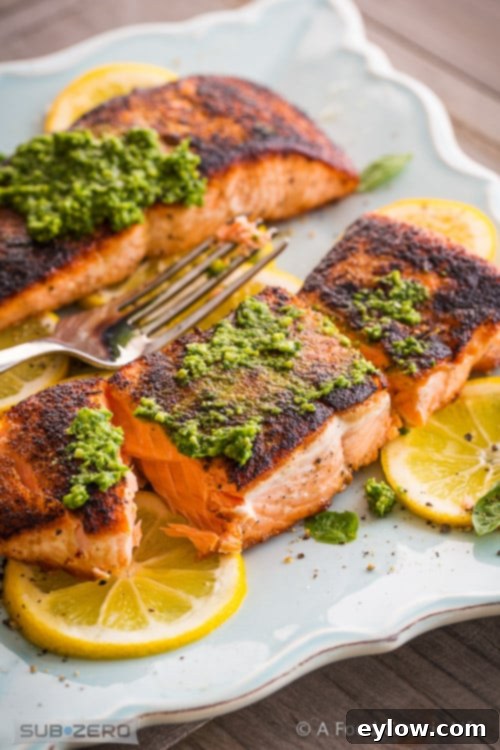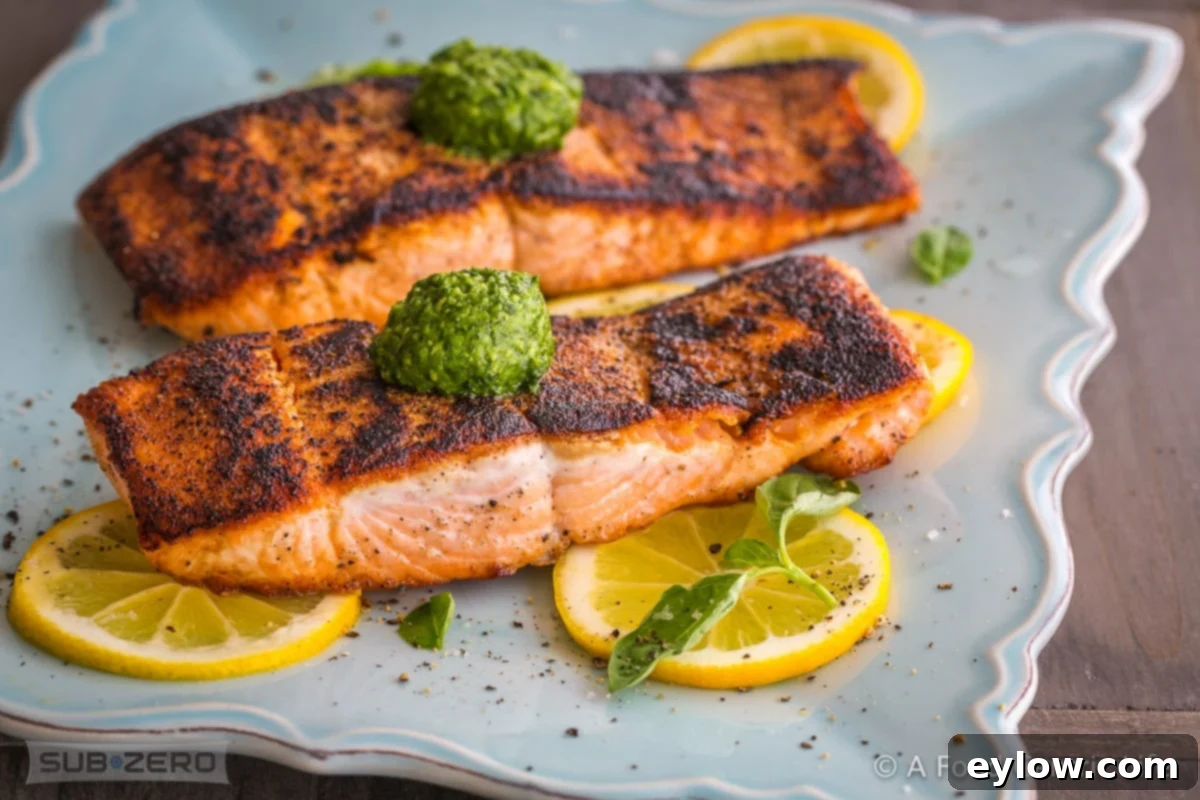Master the Perfect Pan-Seared Salmon: Achieve Flawless Stovetop Fillets Every Time
If the thought of cooking fish at home typically fills you with dread, you’re certainly not alone. Many home cooks find fish intimidating, fearing dry, bland results or, worse, having it stick to the pan. However, this comprehensive guide to **simple stovetop salmon** is designed to transform those anxieties into confidence, making you a pro in no time. This foolproof pan-searing method isn’t just a recipe; it’s a technique that guarantees restaurant-quality salmon in minutes. Imagine serving beautifully cooked fillets with an irresistible golden, crispy crust and a tender, incredibly juicy center. Once you’ve mastered this fundamental approach, you’ll never hesitate to cook salmon again. It’s incredibly quick, reliably delicious, and the best part? This versatile method works beautifully for a variety of other fish fillets too, instantly becoming your newest weeknight staple in your dinner rotation.

Achieving perfectly pan-seared salmon is far simpler than you might think, requiring only the right tools and a few crucial tips. Say goodbye to stress and stubborn sticking. Salmon itself is a powerhouse of nutrition, naturally abundant in high-quality protein, essential heart-healthy omega-3 fatty acids, and vital vitamin D. This makes it an exceptionally smart and nourishing choice for any meal, especially when you need a quick, healthy dinner. To cook it to perfection and serve it with absolute confidence, all you truly need is a reliable non-stick skillet and a modest amount of a good quality cooking oil. With these basics covered, you’re well on your way to enjoying succulent salmon that rivals your favorite restaurant.
Beyond its culinary appeal, embracing salmon in your diet offers profound health benefits. Omega-3s are renowned for supporting brain health, reducing inflammation, and promoting cardiovascular wellness. The high protein content keeps you feeling full and satisfied, aiding in weight management and muscle maintenance. Furthermore, salmon is one of the few natural dietary sources of vitamin D, which is crucial for bone health, immune function, and mood regulation. By integrating this simple stovetop salmon technique into your cooking repertoire, you’re not just preparing a delicious meal; you’re investing in your overall health and well-being, making it an indispensable part of a balanced diet.
[feast_advanced_jump_to]
Why You’ll Adore This Easy Pan-Seared Salmon Recipe
Once you try this pan-seared salmon, it will quickly become a cherished favorite in your kitchen. Here’s why this recipe stands out and why you’ll find yourself returning to it again and again:
- Foolproof Technique for Perfection Every Time – This isn’t just about following steps; it’s about understanding a method that guarantees perfectly cooked salmon. The pan-searing approach creates a beautiful, crisp exterior while keeping the inside tender and juicy, preventing the common pitfalls of dry or undercooked fish. It builds confidence with every fillet.
- Incredibly Quick & Easy Dinner Solution – From start to finish, this recipe is ready in under 15 minutes. It uses just a few simple, accessible ingredients and minimal fuss, making it ideal for busy weeknights when you need a wholesome meal without spending hours in the kitchen.
- Nutritious, Healthy & Deeply Satisfying Meal – Salmon is a nutritional superstar. Each serving is packed with high-quality protein, essential omega-3 fatty acids (crucial for heart and brain health), and vitamin D. It’s a meal that not only tastes fantastic but also nourishes your body, leaving you feeling truly satisfied.
- Minimal Cleanup for Maximum Convenience – Who loves doing dishes? Nobody! This recipe uses just one nonstick pan and a spatula, meaning cleanup is a breeze. No need for the oven, multiple baking sheets, or complicated equipment – just simple, straightforward cooking and easy tidying up afterwards.
- Infinitely Versatile for Endless Flavor Combinations – While delicious on its own, this pan-seared salmon acts as a perfect canvas for countless flavor profiles. You can switch up your spices, add different sauces, or serve it with various sides to create a completely new dining experience each time.
For those who prefer to prepare their fish from scratch, follow these easy directions for how to skin salmon at home. This simple step can make a big difference in presentation and cooking consistency.
Essential Ingredients for Pan-Seared Salmon
Crafting the perfect pan-seared salmon begins with selecting the right ingredients. Quality matters, especially when it comes to fresh fish. Here’s what you’ll need to create this delectable dish:

- Salmon Fillets – The star of our dish! I personally lean towards king salmon fillets due to their rich flavor and buttery texture. When sourcing, fresh wild salmon is always the top choice if available, offering superior taste and a vibrant color. However, its availability can be limited and seasonal, so a good quality farmed salmon is a perfectly acceptable and delicious alternative. For year-round enjoyment, you might even find excellent wild king salmon frozen, which retains much of its quality if handled correctly. Aim for fillets that are about 1 to 1.5 inches thick for optimal searing and even cooking.
- Sea Salt – A fundamental seasoning that enhances salmon’s natural flavors. Use a fine or medium-grain sea salt for even distribution.
- Ground Black Pepper – Adds a subtle, peppery kick that complements the richness of the fish.
- Neutral Cooking Oil – A high-smoke-point oil is crucial for achieving that perfect crust without burning. Options like olive oil, avocado oil, or grapeseed oil work beautifully. Avoid vegetable oils as they often have lower smoke points and less desirable flavor profiles when heated to high temperatures. We’ll discuss more about oil selection in the “Chef’s Tip” section below.
See the recipe card at the bottom of this post for precise measurements for salt, pepper, and oil. These quantities are generally a good starting point and can be adjusted to your personal taste.
Chef’s tip on buying salmon and sustainable choices: Choosing the right salmon can significantly impact your dish. Wild king salmon is often considered the “gold standard” for its flavor and texture, but as mentioned, it’s becoming increasingly rare and expensive. When selecting salmon, look for firm flesh that springs back when gently pressed, and a fresh, clean scent, not overtly fishy. For more extensive and current information on purchasing sustainable seafood, I highly recommend checking out the Monterey Bay Aquarium’s Seafood Watch website. Their resources are invaluable for making environmentally responsible choices. Specifically, explore their Sustainable Salmon Guide to understand the best options available in your region, whether wild-caught or farmed.
Step-by-Step Instructions: Pan-Searing Salmon Like a Pro
Follow these detailed instructions to create succulent, perfectly seared salmon that will impress even the most discerning palates. Precision in preparation and cooking technique is key to achieving that desirable crispy crust and moist, flaky interior.
Prep Salmon: The Foundation for Success
Proper preparation of your salmon fillets is the first crucial step towards culinary success. Taking a few moments here will ensure even cooking and an optimal eating experience.
- Skin Removal (or Not!): If your salmon fillets still have the skin on, you have a couple of options. You can easily remove the skin yourself at home using a sharp, flexible fillet knife, or simply ask your fishmonger to do it for you when you purchase the fish. While I typically prefer skinless for pan-searing to ensure a consistent crust on both sides, some people enjoy crispy salmon skin. If you opt to keep it, sear skin-side down first for a longer period to achieve maximum crispness.
- Portioning Large Fillets: For larger pieces of salmon, it’s beneficial to cut them into individual portions before cooking. Aim for pieces roughly 4-6 ounces each. This not only makes them much easier to handle in the pan but also ensures more even cooking throughout all pieces, as thinner edges won’t overcook while the thicker parts catch up.
- Checking for Pin Bones: This step is often overlooked but essential for an enjoyable meal. Run your fingers firmly over the surface of the fillet, feeling for any small, needle-like bones. These are typically located along the lateral line. Once detected, use kitchen tweezers or even needle-nose pliers to gently grasp and pull them out. (Pro tip: I personally find fly fishing pliers incredibly effective for this task – they offer excellent grip and precision!)
- Trimming the Dark Bloodline (Optional): If you or your guests are sensitive to a stronger “fishy” flavor, consider trimming away the dark, brownish-red bloodline that often runs along the center of the fillet. This section tends to have a more pronounced flavor and is frequently the reason some individuals believe they dislike salmon altogether. Removing it can result in a milder, more delicate taste.

The Art of Pan-Searing Salmon: Achieving Crispy Perfection
Now that your salmon is perfectly prepped, it’s time for the main event: pan-searing. This method is all about building that incredible crust and locking in moisture.
- Season Generously: Begin by seasoning the top side of each salmon fillet (this will be your “presentation side”) with salt, pepper, or your preferred spice rub. Don’t be shy with the seasoning, as it contributes significantly to the flavor and crust development.
- Heat the Pan and Oil: Place a good quality nonstick skillet over medium to medium-high heat. Add about 1 teaspoon of a neutral, high-smoke-point oil (like avocado, grapeseed, or light olive oil). Allow the oil to heat until it shimmers and just begins to show wisps of smoke – this indicates it’s hot enough to create an instant sear.
- The Initial Sear (Seasoned Side Down): Carefully place the salmon fillets, seasoned side down, into the hot pan. This is the crucial step for forming that beautiful crust. Once the salmon is in the pan, resist the urge to move it around. Let it sear undisturbed for 4-6 minutes, or until a deeply golden-brown crust forms. The magic of pan-searing happens when the fish is left alone to caramelize. You can sear it until it’s a light golden, or for a more intense flavor and texture, aim for a darker, almost “blackened” effect. Remember, the longer the initial sear, the less time it will need to finish cooking after flipping.
-
Chef’s Note on Spice Rubs: If you’re using a spice rub that contains delicate herbs or sugars, it’s wise to lower the heat slightly to medium or even medium-low during the initial sear. Spices can burn quickly, turning bitter. Keep a close eye on the salmon; it can go from perfectly golden to scorched in a matter of seconds.
- Flip and Finish: Once the desired crust has formed on the bottom, gently flip the salmon fillets using a thin, wide spatula. Immediately reduce the heat to low. Cover the pan with a lid. This traps steam and gently finishes cooking the salmon, ensuring it remains incredibly moist and tender.
- Check for Doneness: Continue cooking for another 2-5 minutes, depending on the thickness of your fillets and how long you seared them initially. The best way to check for doneness is with a digital instant-read thermometer inserted into the thickest part of the fish. Aim for an internal temperature of 135-145°F (57-63°C). For a moist, just-done center, 135-140°F is ideal; 145°F will yield a fully cooked, firmer texture. Thinner fillets, naturally, will cook much faster, often in just a few minutes after flipping. The flesh should also flake easily with a fork, but still appear slightly translucent in the very center.
- Rest and Serve: Remove the salmon from the pan and let it rest for a minute or two before serving. This allows the juices to redistribute, ensuring maximum flavor and tenderness.
By following these steps, you’ll consistently achieve pan-seared salmon that is flavorful, perfectly cooked, and visually appealing. Enjoy!
Maximizing Freshness: The Importance of Superior Refrigeration
In today’s economic climate, where grocery costs are continuously on the rise, extending the freshness of your food isn’t just a convenient perk—it’s an absolute necessity. Protecting your investment in quality ingredients, especially premium seafood like salmon, truly highlights why the refrigeration system you choose for your home matters immensely. Over the years, across three different homes, I have consistently relied on and chosen Sub-Zero appliances, and each experience has reinforced my satisfaction, not just with their performance but also with their exceptional customer service.
What truly distinguishes Sub-Zero from its competitors is its innovative dual refrigeration technology. This cutting-edge system ensures that refrigerators and freezers operate on entirely separate, optimized cooling systems. This distinct separation is crucial for creating the ideal environmental conditions for different types of food. For instance, frozen foods benefit from a cold, dry air environment, which prevents freezer burn and maintains their taste and texture for longer. Simultaneously, refrigerated ingredients, particularly delicate items like fresh salmon, thrive in a cool, humid air setting – precisely the conditions needed to preserve their freshness, flavor, and nutritional value. When you consider that food is a significant investment, it becomes clear that your refrigeration system should be viewed with the same importance.
Beyond its unparalleled food preservation capabilities, Sub-Zero’s built-in design offers a sleek, sophisticated, and timeless aesthetic that seamlessly integrates into any kitchen decor. The commitment to quality and longevity is evident in every detail. For those seeking to elevate their kitchen with appliances that offer both superior performance and elegant design, I encourage you to visit the Sub-Zero website to explore their range of products. You can also connect with their community and discover more about their offerings on their Facebook page.

Delicious Ways to Serve Your Pan-Seared Salmon
These perfectly quick-seared salmon fillets are an incredibly versatile canvas, ready to be paired with a multitude of flavors. Whether you prefer a simple, elegant presentation or a bold, adventurous topping, salmon adapts beautifully. Here are some of my favorite ways to serve this delicious dish:
- A Simple Squeeze of Lemon: Sometimes, less is more. A fresh wedge of lemon squeezed over the hot salmon brightens the flavor and enhances its natural richness, offering a pure and classic experience.
- Fresh Pineapple Mango Salsa: For a vibrant, tropical twist, a homemade pineapple mango salsa adds a burst of sweet, tangy, and slightly spicy notes that beautifully complement the salmon. The fresh fruit provides a wonderful textural contrast.
- Zesty Tomatillo Salsa Verde: If you crave tangy, smoky brightness, a spoonful of tomatillo salsa verde offers a refreshing and zesty kick. Its herbaceous quality and subtle heat elevate the salmon without overpowering it.
- Rich Basil Pesto: A dollop of classic basil pesto provides an herbaceous richness and a nutty depth that pairs exceptionally well with the omega-3 rich salmon. It’s a timeless combination that feels gourmet yet is incredibly easy to add.
- Smoky Creamy Harissa Aioli: For those who enjoy a bit of warmth and exotic flavor, this smoky harissa aioli is a game-changer. It takes just two minutes to whip up and adds a creamy, spicy, and deeply savory element that transforms the dish.
- Garlic Butter Sauce: A simple, luscious garlic butter sauce drizzled over the top adds an irresistible richness and aromatic goodness that’s always a crowd-pleaser.
- Fresh Dill and Yogurt Sauce: For a lighter, Mediterranean-inspired touch, a creamy Greek yogurt sauce mixed with fresh dill, lemon juice, and a hint of garlic offers a refreshing contrast.
The beauty of this simple salmon technique is its adaptability. Just by switching up the topping or sauce, you can create a completely new meal experience, keeping your dinner rotation exciting and fresh. To complete your meal, simply add a side of fluffy rice, quinoa, roasted vegetables, or a crisp green salad, and you are all set for one truly terrific and satisfying meal!
Frequently Asked Questions About Pan-Seared Salmon
Here are answers to some of the most common questions about preparing and cooking pan-seared salmon, designed to help you achieve perfect results every time.
For pan-searing, I highly recommend looking for skinless fillets of varieties like Atlantic, King (Chinook), or Sockeye salmon. These types generally have a good fat content and firm texture that holds up well to the searing process, developing a fantastic crust. Thicker cuts, typically 1 to 1.5 inches, are easier to cook evenly without drying out the edges. If you’re using wild salmon, which tends to be leaner, keep a closer eye on it as it will cook faster due to its lower fat content. Farmed salmon, with its slightly higher fat, can be more forgiving.
While I personally prefer to remove the skin for a more uniform crust and easier seasoning of the entire fillet, it’s absolutely not mandatory. If you choose to keep the skin on, you can sear the salmon presentation side down first until beautifully golden, then flip it and finish cooking skin-side down. The skin acts as a protective layer and can become wonderfully crispy. Once the salmon is done, the cooked skin will often peel off easily if you prefer not to eat it. However, removing the skin before cooking allows for more even seasoning across the entire fish and gives you the option to trim away the darker bloodline if you’re aiming for a milder flavor profile.
Absolutely! This versatile pan-searing method works exceptionally well with many other types of firm, flaky fish fillets. Excellent choices include halibut, steelhead trout (which is very similar to salmon), Arctic char, cod, or snapper. The key is to adjust the cooking time based on the thickness of the fillet – thinner fish will cook much faster. For lighter, more delicate fish, a great tip is to pour a small amount of white wine or lemon water into the pan after flipping, then quickly cover it with a lid. This steams the fish to finish cooking, ensuring it remains incredibly moist and prevents it from drying out.
If your salmon is sticking, it’s usually due to one of a few reasons. First, ensure you’re using a quality nonstick skillet – it makes a huge difference. Second, don’t rush the sear. The most common mistake is trying to flip the fish too soon. A perfectly seared crust will naturally release from the pan when it’s ready. If it’s sticking, it simply hasn’t developed that crust yet, so give it more time. Using a bit of neutral, high-smoke-point oil (like avocado or grapeseed) and ensuring your pan is adequately preheated to medium-high heat also helps create a nonstick surface. If you notice it sticking and developing too dark, you can always slightly lower the heat.
The most accurate way to determine if your salmon is done is by using a digital instant-read thermometer. Insert it into the thickest part of the fillet. An internal temperature of 135-140°F (57-60°C) is ideal for a moist, tender, and just-done center that still has a hint of translucency. If you prefer your salmon more fully cooked, aim for 145°F (63°C). Visually, the flesh should flake easily with a fork, and the color should change from translucent to opaque, with only a slight hint of pink in the very center if you like it medium-rare. Overcooking can quickly lead to dry, unappetizing salmon, so relying on a thermometer is your best bet!
Choosing the right oil is crucial for a successful sear. You need an oil with a high smoke point that won’t burn or impart off-flavors at the medium-high temperatures required. My top recommendations are avocado oil, grapeseed oil, or a light olive oil (not extra virgin, as it has a lower smoke point). These oils are neutral in flavor and can withstand the heat. Avoid butter alone for searing as it burns easily; if you want a buttery flavor, add it at the very end of cooking or clarify it first. For healthy alternatives, consider Zero Acre Farms oil which I mention in the recipe notes.
Explore More Delicious Salmon Creations
If you’ve fallen in love with cooking salmon after mastering this pan-searing technique, you’ll be thrilled to discover the wide world of other delicious salmon recipes! Each method brings out unique qualities of this versatile fish. Try these other fantastic salmon recipes to expand your culinary repertoire, and don’t forget to check out the comprehensive seafood recipe index page for even more inspiring ideas for fish and shellfish.
- How to Make Steamed Salmon
- Sesame Crusted Salmon
- The Best Smoked Salmon Dip Recipe
- Baked Pistachio Crusted Salmon
Did You Master This Pan-Seared Salmon Recipe?
We absolutely love hearing from you! If you’ve tried your hand at this simple stovetop salmon recipe, please take a moment to add your comment below. Your feedback and experience are invaluable to us and to other home cooks looking for reliable, delicious recipes. And if you truly loved it and found it helpful, we would be incredibly grateful if you could give it a 5-star rating! Your ratings truly help other readers discover and confidently prepare this amazing dish. Happy cooking!
This post is proudly sponsored by Sub Zero Wolf, a brand dedicated to preserving the freshness and quality of your culinary ingredients.
📖 Recipe: Simple Stovetop Pan-Seared Salmon

Simple Stovetop Pan-Seared Salmon
Sally Cameron
Pin Recipe
Equipment
-
High-Quality Non-stick Pan (10-12 inch)
-
Wide, Thin Spatula
-
Digital Instant-Read Thermometer (highly recommended)
-
Kitchen Tweezers or Needle-Nose Pliers (for pin bones)
Ingredients
- 1 ½ pounds salmon fillet, skinned preferably King, Sockeye, or Atlantic, cut into 4 even 4-6oz portions
- ½ teaspoon fine sea salt
- ½ teaspoon freshly ground black pepper
- ¼ teaspoon granulated garlic (optional, for added flavor)
- 1 teaspoon high-smoke-point oil (such as olive oil, avocado oil, or grapeseed oil; avoid standard vegetable oil)
Instructions
-
Thoroughly pat the salmon fillets dry with paper towels. Season the top side (the side you want to present) generously with sea salt, freshly ground black pepper, and optionally, granulated garlic.
-
In a medium-sized, high-quality non-stick pan, heat the cooking oil over medium to medium-high heat until it shimmers and is just about to smoke. Carefully place the seasoned salmon fillets, seasoned side down, into the hot pan. Allow the salmon to sear undisturbed for 4-6 minutes, or until a beautiful, browned crust is formed. You can aim for a light golden crust or continue searing for a darker, almost blackened effect, depending on your preference. Resist the urge to move the fish until it’s ready to flip!
-
Once the crust is established, gently flip the salmon fillets with a wide, thin spatula. Immediately reduce the heat to low and cover the pan with a lid. Allow the salmon to finish cooking for another 2-5 minutes. The precise timing will depend on the initial searing duration and the thickness of your fillets. Cook until the internal temperature reaches 135° – 145°F (57-63°C) for desired doneness (135-140°F for medium-rare to medium, 145°F for medium-well). Serve immediately with a sauce or topping of your choice, or simply a squeeze of fresh lemon.
Notes
Cooking Oil Recommendation: For a truly clean and healthy cooking experience, consider trying Zero Acre Farms oil. Unlike conventional vegetable oils (which are often highly processed and less healthy), Zero Acre Farms offers a superior option with a very high smoke point and neutral flavor profile, perfect for searing. While you currently have to order it online, I find it’s well worth the effort for the health benefits and performance (please note: I have no affiliation with the company, just a satisfied user).
Don’t Overcrowd the Pan: If cooking more than two fillets, work in batches to avoid overcrowding the pan. Overcrowding lowers the pan’s temperature, leading to steaming instead of searing, which prevents the formation of that desirable crispy crust.
Seasoning Variations: Feel free to experiment with your seasoning beyond just salt and pepper. Smoked paprika, a pinch of cayenne, onion powder, or even a pre-made seafood rub can add wonderful depth of flavor. Just remember the Chef’s Note about lowering the heat slightly when using spice rubs to prevent burning.
